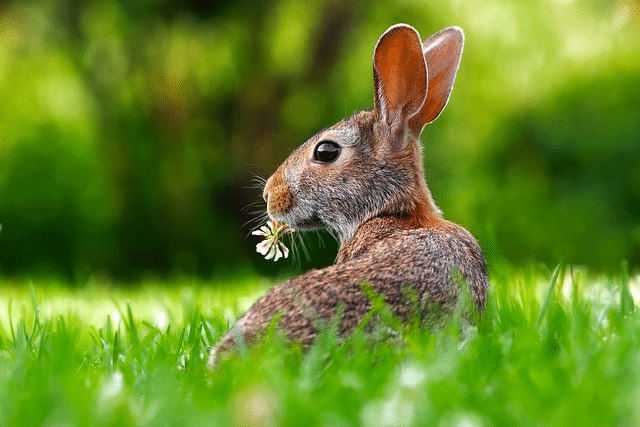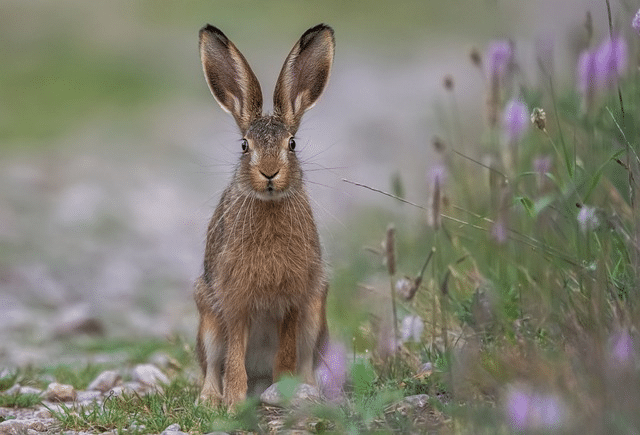Owning a pet rabbit can be an incredibly rewarding experience. They are cuddly and make great companions, often forming strong bonds with their owners. But have you ever wondered: if your bunny were to escape or be released into the wild, could it survive? Could they fend for themselves in their natural habitat or do they still need our help even when living outside of captivity? can pet rabbit survive wild alone? The answer might surprise you! In this blog post, we’ll look at some factors that determine how likely rabbits are to survive in the wild — including diet, habitats, and predators. So take a deep dive into the world of wild rabbits with us as we explore whether these beloved pets could actually make it on their own!
Overview of pet rabbits and their needs
Pet rabbits are adorable creatures that make wonderful companions. However, it’s important to understand their needs to ensure they thrive in your care. Firstly, rabbits need adequate space to move around, play, and explore. They should be provided with a large enough indoor or outdoor area, equipped with appropriate bedding, litter boxes, and toys. Their diet should consist of hay, fresh vegetables, and a small number of pellets. It’s also essential to provide them with regular exercise and socialization, as they love interacting with humans and other rabbits. Understanding these basic needs can help you create a safe and happy environment for your furry friend.

What wild rabbits look like, and how they differ from pet rabbits
Wild rabbits are fascinating creatures that can often be found hopping through meadows and fields. Unlike their domesticated counterparts, wild rabbits are typically smaller in size and have a distinct brown or grey coat that helps camouflage them in their natural surroundings. One of the most noticeable differences between wild and pet rabbits is their behavior. Wild rabbits are typically more skittish and cautious due to their constant threat of predators, while pet rabbits are typically more relaxed and comfortable around humans. Additionally, wild and domesticated rabbits have sleek bodies and large ears that help them detect predators from a distance. Regardless of their differences, both wild and pet rabbits are adorable and fascinating animals to observe.
Common predators of rabbit populations in the wild
In the wild, rabbits face a number of predators that are constantly on the lookout for a tasty meal. These predators range from agile hunters like hawks and eagles to stealthy ground-dwellers like foxes and weasels. Even snakes, both venomous and non-venomous, often hunt and kill rabbits. However, the most dangerous predator of all rabbits is human hunters who have been responsible for their population decline. Despite the threat of these predators, rabbits have adapted well over time to escape predators by becoming fast runners and by burrowing into holes to hide. As a result, rabbits have managed to survive in the wild for centuries.
Special considerations for a pet rabbit’s diet in the wild
In the wild, rabbits are free to graze on a wide range of food sources, from grasses and leafy greens to twigs and bark. But for pet rabbits, their diet requires more careful consideration. While hay should be the staple of a domestic rabbit’s diet, it’s important to supplement their meals with fresh vegetables and fruit. Avoid feeding your rabbit foods that are high in sugar, starch, or fat, and be mindful of any toxic plants that may be growing in your yard. Remember, a rabbit’s digestive system is delicate, so it’s important to introduce new foods gradually and to always ensure that they have access to clean water. With a little extra care and attention to their dietary needs, your pet rabbit can thrive and remain healthy for years to come.
The risks associated with releasing your pet rabbit into the wild
Pet rabbits make adorable fluffy companions, but they’re not equipped to survive in the wilderness. There are several risks associated with releasing your beloved bunny into the wild. First, rabbits are prey animals and lack the necessary survival skills to avoid predators. They may not be able to find food or shelter, and these feral rabbits could potentially introduce diseases to the wild rabbit population. Additionally, domestic rabbits have been selectively bred to have different fur colors and patterns, making them easily identifiable to predators. If you can no longer care for your pet rabbit, it’s crucial to find a safe and responsible way to rehome them, rather than putting their lives at risk in the wild.

Alternatives to releasing a pet rabbit into the wild that can help support existing wildlife populations
Releasing a pet rabbit into the wild may seem like a humane option, but it can actually be quite harmful to exist wildlife populations. Fortunately for pet owners, there are alternatives that can help support these populations while still giving your pet rabbit a good home. One option is to surrender your rabbit to a local animal shelter or rescue group. This way, they can properly care for your pet and potentially even find them a forever home. Another option is to create a rabbit sanctuary in your own backyard, offering them a safe and comfortable environment while still being contained. By exploring these alternatives, you can ensure that both your beloved pet and existing wildlife populations are protected.
How long can rabbits live in the wild?
It can live in the wild for an average of three to five years, depending on its environment and availability of food. However, if the habitat is not ideal or is lacking resources, rabbits may struggle to survive longer than one year. Proper care, such as providing a safe outdoor space with plenty of fresh vegetation and access to water, can help domesticated rabbits survive and thrive in the wild for more extended periods. Additionally, if you are considering releasing your pet rabbit into the wild, it is essential to consider their health and whether they have the necessary skills to survive on their own. Releasing a domesticated rabbit without these abilities could put them at risk.
Outdoor weather
Our pets don’t like extreme weather conditions of the weather either. A thick coat can make hot and humid areas dangerous for a rabbit. Rabbits have heat strokes at a temperature above 80oF. When left alone without protection, rabbit heat is extremely high. Rain can sometimes cause problems, especially during the hottest days. Rabbits don’t get dried up fast. When they get wet, the rabbits’ coat gets drenched throughout the day. It can also affect rabbits in that they are incapable of controlling their temperatures, resulting in hyperthermia.
My Rabbit Escaped, Will It Survive?
It is unlikely that an escaped rabbit will survive in the wild. Without any prior survival skills, the escaped pet may not have any survival instincts or the knowledge or abilities to find food and shelter, making them vulnerable to predators or disease. It is essential to stay vigilant if your bunny ever escapes and take immediate action by searching for them. Additionally, it is important to consider why they escaped in the first place and take steps to ensure it doesn’t happen again. If you can no longer care for your rabbit, look into rehoming options such as a local animal shelter or rescue group. This way, you can ensure that your pet will be safe from possible dangers out in the wild.
Another thing to consider when it comes to keeping rabbits outdoors is the temperature. Rabbits can withstand cold temperatures, but should always be kept in a warm and sheltered area. During extreme temperatures, such as hot or cold weather, it’s important to provide your pet with additional shelter and protection from the elements. Additionally, look for warning signs that your rabbit may be uncomfortable, such as panting or shivering. If your rabbit displays any of these signs, bring them indoors to keep them safe and comfortable.
Overall, releasing a pet rabbit into the wild can be harmful to both wildlife populations and your beloved pet. For the safety of your rabbit and others, explore alternatives such as surrendering them to a local rescue group or creating a safe environment for them in your backyard.
The flip side: when outdoor rabbits do survive
Rabbits that do manage to survive outdoors often thrive in their environment. They develop skills essential for survival, such as finding food and shelter on their own. These rabbits may become more independent and may even form small colonies with other wild rabbits. However, despite the potential benefits of a wild lifestyle, it’s important to remember that these rabbits will no longer be domesticated and, as a result, may become more difficult to handle In addition, it is possible for these wild rabbits to pass on illnesses such as Myxomatosis or VHD (Viral Hemorrhagic Disease) to your pets if not properly isolated. Therefore, it is important to always keep an eye on any wild rabbit populations in your area and take the necessary precautions to protect your pet rabbits.

Should I let my rabbits roam free?
No. As much as possible, it is always best to keep pet rabbits in a secure area or indoor enclosure to prevent them from escaping and getting lost. Releasing pet rabbits into the wild can be extremely detrimental to wildlife populations due to a lack of proper skills and resources, so it is important to find a safe and responsible way to rehome your pet rabbit. Additionally, if you do choose to keep rabbits outdoors, you must provide them with adequate shelter and protection from the elements to ensure their safety. With proper care and consideration, both your beloved pet and existing wildlife populations can be protected.
Are pet rabbits happier inside or outside?
This really depends on the individual rabbit, as every animal has its own preferences. Generally speaking, pet rabbits are happiest when they have access to both an outdoor and indoor environment. This allows them to be set free to roam and explore their surroundings, while also having a safe place to call home. If you choose to keep your rabbit outdoors, be sure to provide plenty of fresh vegetation and access to water, as well as adequate shelter from the elements. Additionally, it is important to give your rabbit plenty of attention, no matter where they’re living. With love and care, pet rabbits can be happy and healthy indoors or outdoors.
Is Releasing Domestic Rabbits into the Wild Legal?
In most cases, it is illegal to release domestic rabbits into the wild. This is due to the fact that pet rabbits lack the skills and resources they need to survive in the wild, which can cause them harm and even death. Additionally, releasing a pet rabbit into the wild can also put existing wildlife populations at risk of early death by introducing new diseases or disrupting the existing ecosystem. Therefore, it is important to always check local laws and regulations before releasing a pet rabbit into the wild, as doing so without the proper permits can lead to hefty fines or even jail time.
Releasing a pet rabbit into the wild should be an absolute last resort and avoided at all costs, as there are much safer and more responsible ways of rehoming a pet rabbit. If you are unable to properly care for your pet rabbit, it is important to find a responsible rescue group or other individuals to take them in. Additionally, there are also many resources available online that can provide helpful advice and information on how to properly care for a pet rabbit in any environment.
At The End
there are cases of pet rabbits surviving the wild, But to do so successfully, pet rabbits must be able to have the skills and resources necessary for living in the wild. This can include foraging for food, finding shelter, and building a social network with other wild rabbits. However, if not done properly, releasing pet rabbits into the wild can lead to negative outcomes such as illness or death.



